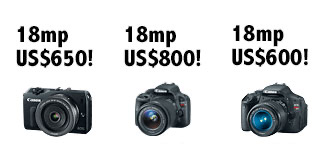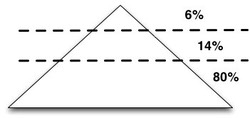
(commentary)
We've got camera designers all over the place lately: FX DSLRs, APS compacts, small-sensor mirrorless, and every other variation you can think of. Basically mix and match any of the following:
- 1", m4/3, APS/DX, FX sensor
- fixed prime lens, fixed zoom lens, interchangeable lenses
- compact, mirrorless, DSLR
One problem? The products that get produced all tend to end up in the same price ranges, overlap in weird ways, or worse, end up outside the expected price range (I'm looking at you, Coolpix A).
Rationally, here's what probably should be happening with large sensor cameras:
- Fixed zoom or prime lens at bottom of price range (US$500-750)
- Interchangeable mirrorless in middle of price range (US$750-1000)
- Interchangeable FX sensor DSLR in top of price range (US$1500+)
iMac, Mini, Mac Pro.
Curiously, Sony comes the closest to this (RX100, NEX, Alpha, if, of course, we ignore the RX1 and we ignore all the APS SLT cameras).
The problem, of course, is that the old screws-cables-buttons-everywhere DSLR makers, Canon and Nikon, sell most of those nearly-antiquated DSLR designs right in those first two pricings: US$500-1000. Those two will play price/performance/branding against almost any entrant that tries dislodge them. Of course, as it turns out, both Canon and Nikon aren't selling as many DSLRs as they thought they would this year, either. Making cameras with thousands of parts in them using only slightly modernized hand manufacturing techniques also means that they have cost issues they eventually need to address, as well. Nikon did that cost management with the Nikon 1 models, which have less than 300 parts, though then they decided to use hand painting to highlight the logo and price them like mid-range DSLRs; go figure.
Imagine this consumer camera lineup:
- Nikon GreatPix A: 24mp DX, built-in collapsing 18-55mm lens or built-in fast 24mm (36mm equivalent) prime, for US$500. Add-on 2x lens adapter, US$150. GreatPix B version with 2m dot EVF: US$650.
- Nikon GreaterPix: 24mp DX F-mount mirrorless, 2m+ dot EVF: US$850.
- Nikon GreatestPix: 24mp FX F-mount DSLR: US$1900.

The 80/20 rule says the GreatPix (A or B) should be all the camera 80% of the market really needs if we define it right (plus we have four variations in that piece where the demand would be greatest, so we can spread the demand with a little bit of incremental pricing grease); the GreaterPix is probably all the camera that 16% of the market need;, and the GreatestPix serves the other 6% of consumers.
Nikon, of course, can't get to such a lineup easily. Oh, the GreatestPix already exists. That's the D600. But the two lower end models would have a big marketing hurdle: why are they better than a D3200, D5200, or D7100, and where does that leave the Coolpix A? Well, I can think of a few things that could make a GreatPix better than a D3200: smaller, lighter, simpler and less prone to repair to start with. From there you'd really have to work hard and deliver better performance, but you'd also need to make these more user-responsive cameras. Bracket anything. True remote control. Radio flash. Dare I say communicating and programmable? ;~)
Sony is looking for a weak chink in the Canon/Nikon market share. So far they seem to be using the spaghetti-at-the-wall approach: DSLRs, near DSLRs, future mirrorless DSLRs, large sensor compacts with zoom and prime lenses with different sensor sizes, mirrorless cameras, what haven't they tried?
Long term the answer is simple: you must build a bottom-to-top group of systems that a user can grow with (which implies that the GreatPix uses the same remote control, menu/control system (subset), programmability, etc., as do the bigger siblings, another problem that the current solutions get all wrong). A set of systems that provides the right performance at the right price, and which is totally clear to the user as to what you make at each of the various levels, and why that matters photographically.
So let's examine that for a moment: Nikon makes DX and FX DSLRs. They make a bunch of other stuff that may or may not fit into that. They haven't filled out the DX lens lineup, so they really want you to buy an FX DSLR. There are different remote controls, different styles of control, and more. It's an iterative mishmash, but at least you have a choice of US$550, US$700 (or 800 with lens), US$1200 (or 1500 with lens), and US$2000 (or 2400 with lens). Is what you get for US$250, US$950, or US$1950 more actually worth that much more? And note how some of the "more" is very arbitrary to try to distinguish a model, as in the swivel LCD only on the D5200. Why isn't swivel LCD on all models higher than a certain point?
I would say that Nikon's strategy got completely off track. While they claim to want the DSLR crown from Canon, they really haven't done all the things that would be necessary to lock in a full, meaningful DSLR lineup that could pull that off. Meanwhile, they produced hundreds of random Coolpix models that leak R&D, time, and money, plus already in less than two years they've produced five Nikon 1 models that are priced like the DSLR line they claim to want to be number 1. While it's not as random as Sony's strategy has been so far, it doesn't exactly look well coordinated across the board.
Let's look again at that Sony lineup: let's see, a 20mp compact for US$650, a 20mp SLT DSLR-like for US$550, a 16mp mirrorless for US$600. Does that look rationalized from a user standpoint? Yes, they have some other options, mostly at higher prices, but I wanted to use those particular examples to show why someone walking into a store carrying Sony products might be scratching their heads. At least the most expensive one of the options I list has something going for it: it fits in your pocket. But why would you opt for the mirrorless over the SLT? Yeah, size again comes partly into play, but you're losing the viewfinder and focus performance, amongst other things.
Canon doesn't exactly get a pass, either, as the illustration up top suggests. Let's see, we have the 14.3mp almost-APS compact G1x at US$600, the 18mp EOS M mirrorless at US$650, the 18mp SL1 DSLR at US$800, and the 18mp 3Ti DSLR still on sale at US$600.
And that brings me to my conclusion: the camera makers are all competing against themselves at a time when the market is shrinking. I spend a lot of each day explaining to people what the tangible and intangible differences are in all these camera offerings, and how that might impact their buying decision. Most people walking into a camera store get almost immediately confused by the lineups. Too many overlapping options with too many variables to consider. Many at the same price for no apparent reason. Oh, and what color would like that in?
It's beyond time that the camera companies actually develop a coherent strategy other than progressive iteration coupled with random iteration.





